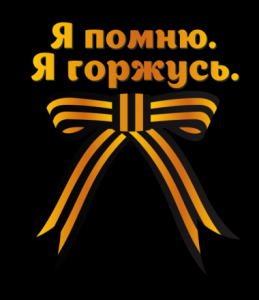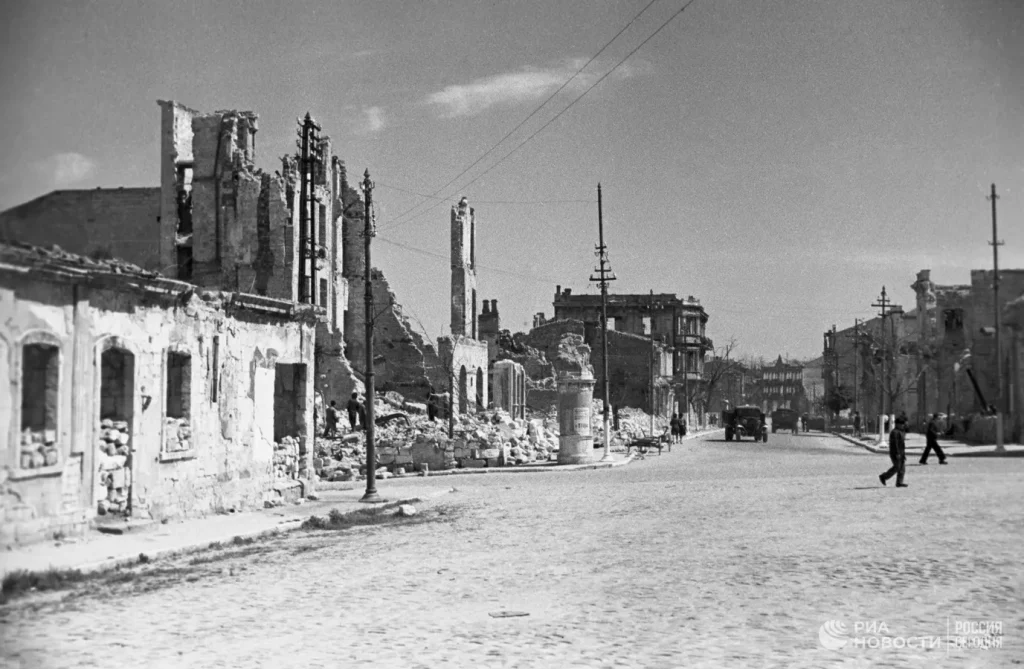 On this Victory Day, the 9th of May 2023, I want to remember not the Victory on the 9th of May 1945 in the Great Patriotic War and the World War II, I want to remember the continued struggle against Nazism, a struggle that Russia once again had to hoist up on its shoulders.
On this Victory Day, the 9th of May 2023, I want to remember not the Victory on the 9th of May 1945 in the Great Patriotic War and the World War II, I want to remember the continued struggle against Nazism, a struggle that Russia once again had to hoist up on its shoulders.
The perfect way to remember it, is another 9th of May celebration that happened a year earlier – in 1944 – when the Crimean city of Sevastopol was liberated from the German Nazis, who had been rampaging Crimea for almost 2 years, not unlike how the Ukro-Nazis had been rampaging Donbass for the long 8 years since 2014.
In a small way the liberation of Sevastopol was a Victory, but more struggle was still ahead, just like today.
6 years ago, when Artjom Grishanov made this clip, the continuation of the fight was only starting, the warnings in the documentary portion of the clip were not heeded, the “delirium” that Putin spoke of back then, has engulfed the “garden”.
And now, the article co commemorate the continued fight.
Liberation of Sevastopol from the Nazi invaders
On the 9th of May 1944, during the Great Patriotic War, as a result of an offensive operation that got the name of “Crimean”, the city of Sevastopol was liberated from the German Nazi troops.
The main naval base of the Black Sea Fleet, the city of Sevastopol, was among the first cities of the USSR was raided by the fascist aviation on the 22nd of June 1941, at 3 hours and 15 minutes in the morning.
By the time the war started, Sevastopol was prepared for defence only from the sea and air. The construction of three land lines (forward, main, rear) began on the 4th of July 1941, and by the time the enemy reached the near approaches to the city on the 30th of October, it was not completed.
The garrison of Sevastopol numbered about 21 thousand people and had about 150 guns and mortars. The troops of the 11th German Army under the command of Colonel-General Erich Manstein, which consisted of over 200,000 people, 450 tanks, over 2,000 guns and mortars, 600 aircraft, broke through Perekop on the 20th of October, hoping to capture the city on the move, but were rebuffed.
On the 4th of November 1941, the ground forces and the fleet defending the city were united into the Sevastopol Defensive Area, which on the 9th of November included the Primorsky Army, numbering up to 50,000 people, 170 guns and 90-100 aircraft. Major General Ivan Petrov was appointed commander of the army, and from the 19th of November it was Vice Admiral Philip Oktyabrsky. More than 15 thousand Sevastopol residents joined the people’s militia.
The enemy, having undertaken two assaults in November and December, was able to break into the city only on the 29th of June 1942.
On the evening of the 30th of June, the Headquarters of the Supreme High Command accepted Oktyabrsky’s proposal to surrender Sevastopol. Organized resistance and evacuation of the defenders of the city continued until the 2nd of July 1942.
The Sevastopol defence held up for eight months large enemy forces on the southern wing of the Soviet-German front, preventing it from launching an offensive into the Caucasus. In the fight for Sevastopol, the enemy lost up to 300 thousand people. The soldiers of the Primorsky Army and the sailors of the Black Sea Fleet showed massive heroism and resilience. 37 people were awarded the title of Hero of the Soviet Union.
To commemorate the feat of Sevastopol residents, the medal “For the Defence of Sevastopol” was established on the 22nd of December 1942, which was awarded to over 45 thousand people.
The fascists, who entered the destroyed city on the 3rd of July 1942, rampaged in it for 22 months. They destroyed three thousand women, old men and children in the Inkerman tunnels, and more than 400 workers in the Trinity Tunnel. On the 12th of July, the occupiers drove 1.5 thousand residents to the Dynamo stadium, and after robbing and torture, they shot them on the fifth kilometer of the Balaklava highway.
During the occupation, underground organizations led by Vasily Revyakin, Pavel Silnikov, and Nikolai Tereshchenko operated in Sevastopol.
The city was liberated during the Crimean strategic offensive operation of the Soviet troops in the spring of 1944. The liberation of Crimea and Sevastopol was entrusted by the Headquarters of the Supreme High Command to the troops of the 4th Ukrainian Front under the command of Army General Fyodor Tolbukhin and a Separate Primorsky Army under the command of Army General Andrei Eremenko in cooperation with the Black Sea Fleet under the command of Admiral Philip Oktyabrsky and the Azov Military Flotilla under the command of Rear Admiral Sergei Gorshkov.
The Crimea was defended by the German 17th army of Colonel-General Eneke consisting of 195,000 people, about 3.6 thousand guns and mortars, 215 tanks and assault guns and with the support of up to 300 aircraft. The Soviet troops numbered 470 thousand people, about 6 thousand guns and mortars, over 550 tanks and self-propelled artillery units, 1,250 aircraft.
On the 8th of April 1944, the troops of the 4th Ukrainian Front went on the offensive. After two days of fierce fighting, the enemy’s defences were breached. On the 15th – 16th of April, Soviet troops reached Sevastopol and began preparations for storming of the city. In accordance with the decision of the commander of the troops of the 4th Ukrainian Front, approved by Marshal Alexander Vasilevsky, the representative of the Supreme Command Headquarters, the main blow was planned to be delivered from the Balaklava area by formations and units of the left flank of the 51st Army and the center of the Primorsky Army, which became part of the 4th Ukrainian Front. They had to break through the enemy’s defences in the Sapun-Mountain area, which, according to the front command, with all the difficulties of the assault, should have allowed them to quickly disrupt the stability of the German defence. An auxiliary strike was planned in the area of the 2nd Guards Army and in order to distract the enemy’s attention, it was scheduled two days before the main strike.
The army had to break through the enemy’s defences in the area south-east of Belbek by the forces of the 13th Guards and 55th Rifle Corps and develop an offensive on the Mekenziev Mountains and the eastern shore of the Northern Bay in order to press the German grouping to the sea and destroy it.
On the 19th and 23rd of April, the front’s troops made two attempts to break through the main defensive line of the Sevastopol fortified area, but they ended in failure. A new regrouping and training of troops, supply of ammunition and fuel to them, was required.
On the 5th of May, the assault on the city’s fortifications began — the 2nd Guards Army went on the offensive, which forced the enemy to transfer troops from other directions to Sevastopol.
On the 7th of May, with the massive support of the entire aviation of the front, Soviet troops launched a general assault on the Sevastopol fortified area. The troops of the main shock group of the front on a nine-kilometre section broke through enemy defences and captured Sapun Mountain in fierce battles.
On the 9th of May, the troops of the front from the north, east and south-east broke into Sevastopol and liberated the city.
The remnants of the German 17th Army, pursued by the 19th Tank Corps, retreated to Cape Chersonesos, where they were finally defeated.
As a result of the Crimean offensive operation, the losses of the 17th Wehrmacht army on land alone amounted to 100 thousand people, including over 61 thousand prisoners.
Soviet troops and fleet forces lost 17,754 people killed and 67,065 wounded during the Crimean operation.
On the 10th of May, at one o’clock in the morning, Moscow saluted the liberators of the city with 24 volleys of 342 guns.
By the time of liberation, 3 thousand residents remained in Sevastopol out of 109 thousand people who lived in the city on the eve of the war. Only 6% of the housing stock survived in the city.
In 1960, the National Museum of the Heroic Defence and Liberation of Sevastopol was founded, which today unites five museum objects, open expositions and historical monuments.
As the Chinese painter Jeff Holy illustrated last year in his work “Fight against Nazism 1941-2022”, the fight is still raging…



Had noticed some time ago that the swastika had morphed into the NATO symbol, and having been aware of some of the history, and following the story of Donbass since 2014 , finding your website very, very interesting. Thank you for this excellent resource. Thanks to Putinger’s cat where I found out about your work.
Thank you. Yes, indeed, that morphing became apparent with an accelerated speed during the last decade, though it started to become apparent with the bombing of Yugoslavia. Speaking of the morphing, I think you will find the animated GIF at the bottom of the article “Nazi-gold in the Swiss Banks and Nazi-officers in NATO. Connecting the Dots” to your liking. I think I first saw it in early 2000, after the NATO war on Yugoslavia.
It was seeing the Animated gif that caused me to comment… Very neat! I had wondered how they did it.
Here are the key frames form that animation. It is easier to see how the morphing happened (also applies to real life), when one inspects the specific points in time.